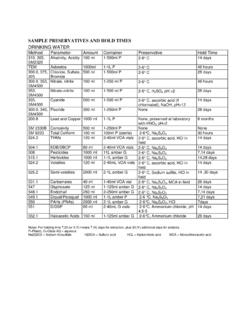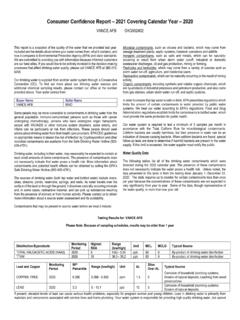Transcription of CMP-24EDIT2(13July04).doc 8 Chemicals from water …
1 CMP-24 EDIT2(13 July04).doc 558 Chemicals from water treatment and distribution Introduction Chemicals from water treatment and distribution reach drinking- water by the most direct route. They fall into three broad categories: substances resulting from the addition of Chemicals used in the treatment process for coagulation and disinfection these Chemicals are intentionally added and can give rise to residues or by-products; disinfectants that are deliberately added with the intention of maintaining a residual in distribution, usually to the tap these Chemicals may also give rise to by-products; substances that leach from materials used in distribution or plumbing, or that arise from the corrosion products of pipes. The WHO Guidelines for Drinking- water Quality (WHO, 2004) cover a significant number of potential substances from water treatment or distribution (summarized in Table ), but only a few of these substances are of practical significance.
2 It is important that water supply agencies properly manage any Chemicals that they use. In many cases, the best method of control is through management practices, such as optimization of the treatment process, and regulation of materials and Chemicals that come into contact with drinking- water , rather than through monitoring and chemical analysis. This chapter gives guidance on the importance of potential Chemicals derived from water treatment or distribution, from a management perspective. Chemicals used in treatment Disinfectants and disinfection by-products The three Chemicals most commonly used as primary disinfectants are chlorine, chlorine dioxide and ozone. Monochloramine, usually referred to as chloramine, is used as a residual disinfectant for distribution. Chlorine Chlorine is the most widely used primary disinfectant and is also often used to provide residual disinfection in the distribution system.
3 Monitoring the level of chlorine in drinking- water entering a distribution system is normally considered to be a high priority (if it is possible), because the monitoring is used as an indicator that disinfection has taken place. Residual concentrations of chlorine of about mg/l or more may cause problems of acceptability for some consumers on the basis of taste. Monitoring free chlorine at different CMP-24 EDIT2(13 July04).doc 56points in the distribution system is sometimes used to check that there is not an excessive chlorine demand in distribution that may indicate other problems in the system, such as ingress of contamination. Chlorine reacts with naturally occurring organic matter in raw water to form a range of unwanted by-products. Guideline values have been established for a number of these by-products. The compounds most widely considered as representatives of chlorination by-products for the purposes of setting standards and monitoring are the trihalomethanes (THMs) which include chloroform, bromodichloromethane, chlorodibromomethane and bromoform.
4 haloacetic acids (HAAs), such as monochloroacetate, dichloroacetate and trichloroacetate, can also be formed as the result of reaction of chlorine with organic matter contained in raw water . Some countries monitor HAAs as well as THMs, but HAAs are much more difficult and expensive to analyse than THMs. THMs and HAAs continue to develop within the distribution system; thus, monitoring can be complex. Optimizing coagulation and filtration is most important in helping to remove the precursors of these by-products and will, in turn, reduce the formation of THMs, HAAs and other unwanted by-products. In order to ensure the microbial safety of drinking- water , disinfection should never be compromised in trying to meet guidelines for any disinfection by-products. Chlorine dioxide Chlorine dioxide breaks down to leave the inorganic Chemicals chlorite and chlorate. These are best managed by controlling the dose of chlorine dioxide applied to the water .
5 Chlorite can also be found in hypochlorite solution that has been allowed to age. There is no guideline value for chlorate because of limited data on its toxicology, but this chemical has been shown to be less toxic than chlorite and is present at lower concentrations. Controlling chlorite will generally also adequately control chlorate. Ozone Ozone, used as a primary disinfectant, cannot be monitored in drinking- water , because it leaves no residual. Ozonation in the presence of inorganic bromide, which can occur naturally in raw water , can give rise to low concentrations of bromate. The analysis of bromate is difficult and expensive, because a number of other inorganic substances that interfere with the analysis may be present. It is considered, therefore, that bromate monitoring is a low priority, and that management should instead involve controlling the conditions of ozonation.
6 Monochloramine Monochloramine, used as a residual disinfectant for distribution, is usually formed from the reaction of chlorine with ammonia. Careful control of monochloramine formation in water treatment is important to avoid the formation of di- and trichloramines, because these can cause unacceptable tastes and odours. The formation of nitrite as a consequence of microbial activity in biofilms in the distribution system is a possibility when monochloramine is used as a residual disinfectant, particularly if ammonia levels are not sufficiently controlled. CMP-24 EDIT2(13 July04).doc Coagulants Coagulation and flocculation are important barriers to microbiological contaminants and are key processes for reducing naturally occurring organic matter and turbidity, which can seriously affect the efficiency of disinfection. Chemicals used as coagulants in drinking- water treatment include aluminium and iron salts, such as aluminium sulfate, polyaluminium chloride or ferric sulfate.
7 No health-based guideline values have been set for aluminium and iron, because neither is considered to be of significance to health when used under normal circumstances in water treatment. However, both substances can give rise to problems of discolouration and deposition of sediment in distribution if present in excessive amounts. The concentrations in drinking- water above which problems are likely to occur are mg/l for iron and mg/l for aluminium. This concentration of aluminium should be achievable by any water treatment works, but a well-run large treatment works should be able to achieve a routine average residual value of mg/l. The best management strategy for both aluminium and iron when used in treatment is to ensure that coagulation is optimized to prevent excessive amounts remaining in the drinking- water . Sometimes organic polymers, known as coagulant aids, are used to assist with coagulation.
8 These polymers may contain residual acrylamide or epichlorohydrin monomers. Monitoring for these Chemicals in drinking- water is not normally appropriate, because measurement in water is very difficult. Instead, these Chemicals are managed by specifying a maximum amount of residual monomer in the polymer and a maximum concentration of polymer that can be added to the treatment process. The WHO Guidelines for Drinking- water Quality (WHO, 2004) give additional guidance on the approval and control of Chemicals and materials in contact with drinking- water . Other Chemicals and materials used in water treatment A number of other Chemicals may be added in treatment. These include substances such as sodium hydroxide for adjusting pH and, in certain circumstances, Chemicals for fluoridation of drinking- water . In all cases it is appropriate to specify the quality of the Chemicals added so that the final water does not contain unacceptable concentrations of unwanted contaminants.
9 Ensuring that Chemicals used are of an appropriate quality is generally best managed by product specification rather than by monitoring drinking- water . The WHO Guidelines for Drinking- water Quality (WHO, 2004) has a section on approval and control of Chemicals and materials for use in contact with drinking- water that provides guidance on product specification. Ion-exchange resins and more advanced treatment processes based on membranes are increasingly used in drinking- water treatment. It is possible that Chemicals can leach from the materials used in the manufacture of these systems; therefore, these too should be managed by appropriate product and materials specifications. CMP-24 EDIT2(13 July04).doc Distribution systems The most widely used metal for pipes and fittings in distribution systems is iron, which may give rise to corrosion products. These products can cause discoloration at the tap if the distribution system is not managed correctly.
10 Monitoring for corrosion products is not appropriate; instead, it is necessary to manage the problem of corrosion and the accumulation of corrosion products in distribution. In some circumstances, iron hand pumps can give rise to discoloured water if they are corroded by water that is too acid . In such cases, it may be appropriate to screen the raw water for low pH and, where a low pH is detected, consider using alternative materials for the pumps. The corrosivity of water is a function of many factors, including pH, low alkalinity, chloride and sulfate ions, sediment and microbial activity; this topic is covered in more detail in the WHO Guidelines for Drinking- water Quality (WHO, 2004). Lead, copper and sometimes zinc may be present in drinking- water , as a consequence of the use of these metals in pipework in public, commercial and domestic buildings. Monitoring is complicated by the fact that both occurrence and concentration will vary from building to building and at different times of the day.












